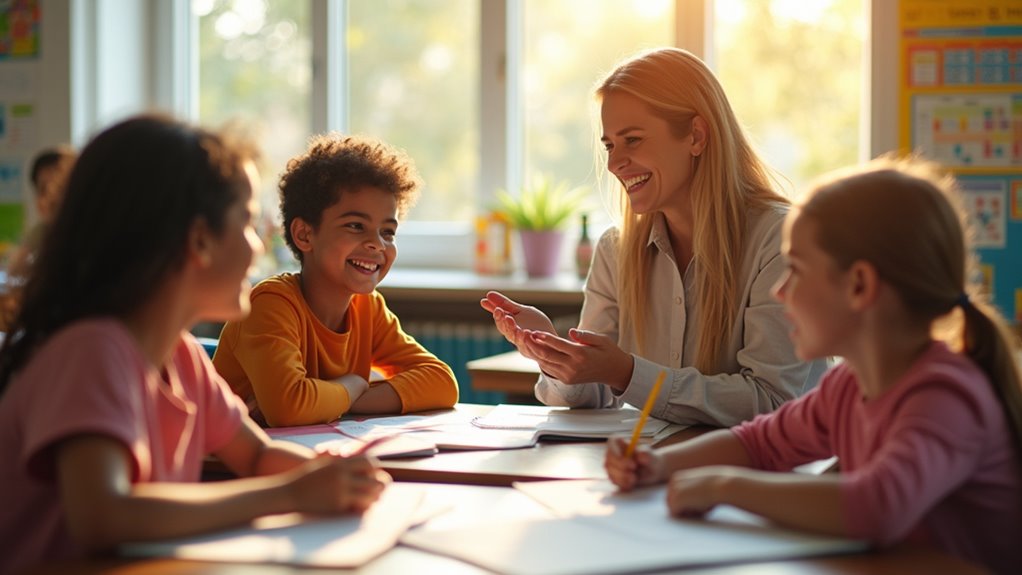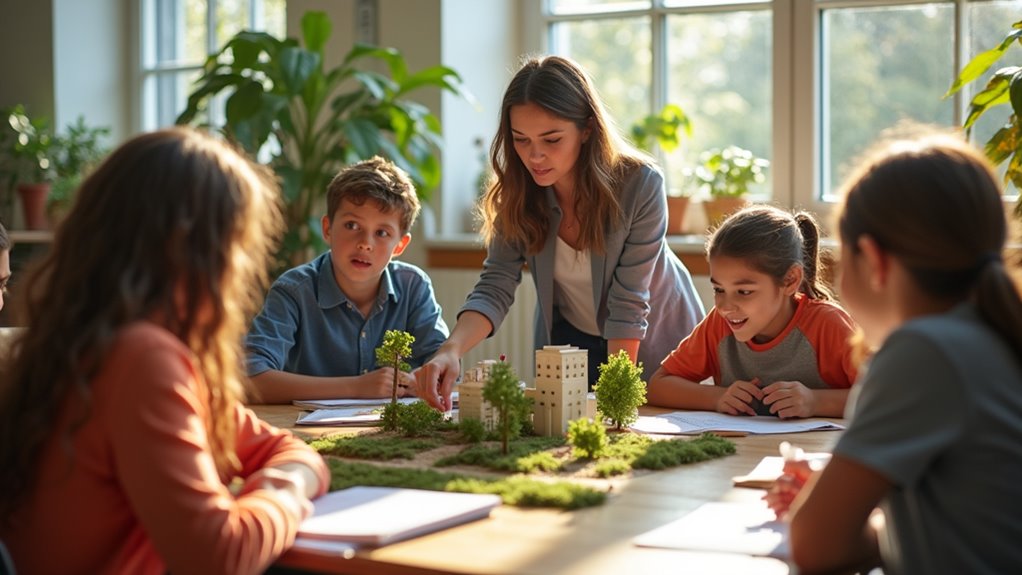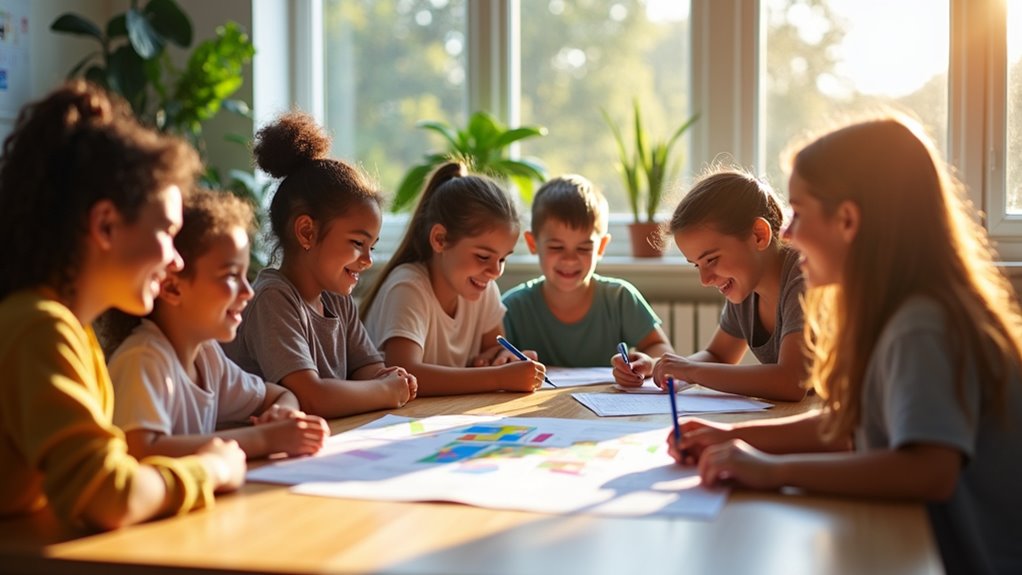How To Motivate Learners In The Classroom
To motivate learners in the classroom, focus on building strong connections by showing genuine interest in their lives, such as asking about their hobbies or challenges. Additionally, use positive feedback, praise effort on difficult tasks like solving a tough math problem, connect lessons to real-world applications like linking science to environmental issues, and set small, achievable goals such as weekly progress checks to foster growth. More practical strategies and detailed insights will be explored further in the article for those seeking a deeper understanding.
Essential Facts in 30 Seconds
- Build strong teacher-student relationships to foster trust and intrinsic motivation.
- Provide positive feedback to enhance confidence and support student growth.
- Connect lessons to real-world scenarios to increase relevance and engagement.
- Establish small, achievable goals to create a sense of accomplishment.
- Implement varied strategies like gamification to keep students interested.
Building Strong Teacher-Student Connections
Building strong teacher-student connections is key to a happy classroom. These bonds inspire kids to learn and grow every day. Focus on emotional skills to understand students’ feelings better. This creates trust, especially for young kids in K-3 grades. Studies show such ties boost grades and social skills for years.
Try mindfulness tricks like deep breathing to stay calm. These help you listen and respond with kindness. A peaceful teacher makes a safe classroom space. Students shine when they feel important to you. Stay friendly and open to their needs always. Positive relationships with students can lead to higher achievement levels. Showing genuine interest in their lives can foster intrinsic motivation.
Make time to hear their thoughts and ideas. Adapt to each child’s unique way of learning. Strong bonds take daily care and real effort. Encouraging a motivated mindset through these connections can enhance academic success. Creating an inclusive environment also supports diverse learners’ engagement. Start now to see more smiles and better marks. Your hard work will pay off big time!
Using Encouragement and Positive Feedback

Building strong bonds with students lays a great base for learning. Positive feedback and encouragement can spark their desire to grow. Try praising their hard work with clear words. Say things like, “Amazing effort on that tough math puzzle!” This boosts their confidence a lot. Also, guide them with small, easy steps. Give tips that fit their needs. This helps them become more independent over time. Self-motivation, nurtured through encouragement, empowers students to overcome learning challenges and persist through difficulties. Research shows that sincere praise can significantly increase extrinsic motivation and self-efficacy among students. A supportive classroom environment can further enhance this by fostering intrinsic motivation and inspiring a genuine love for learning. Celebrating small achievements regularly can also boost student confidence and reinforce their drive to succeed.
Take a look at this simple table for feedback ideas:
| Feedback Type | How to Use It | Effect on Students |
|---|---|---|
| Clear Praise | Point out exact wins | Builds their belief |
| Positive Words | Cheer effort with kind talk | Makes them eager to try |
| Step-by-Step Help | Show small ways to do tasks | Helps them work alone |
| Short Written Notes | Give personal, lasting cheers | Aids growth over time |
Use these tips every day to see excitement rise. Make feedback simple and quick. Always match it to each student. It’s a strong way to help!
Linking Lessons to Real-World Applications

Let’s dive into connecting lessons with real-world uses. This trick makes learning super useful.
Think about using math to plan your spending. Or apply science to get why climate rocks. These links show how your studies matter every day. They help facts stay in your mind. Real-world data can also boost student engagement by making abstract concepts tangible.
You don’t just learn stuff. You use it in real situations. Studies say students remember 40% more this way. Additionally, linking lessons to practical scenarios can foster intrinsic motivation by sparking natural curiosity in students. Teachers can inspire students by demonstrating real-world relevance in everyday lesson plans. Try involving students in hands-on projects like budgeting exercises to solidify these connections with practical applications.
Enhancing Practical Relevance
Bringing real-world value to your lessons makes learning exciting and useful. Think about solving actual business problems or social issues. Study real case studies to see how ideas work in life.
Try hands-on tasks like checking market trends or reading data. These skills matter to future bosses.
You grow sharper by tackling true challenges. Use fresh industry facts to find trends and decide. Take on projects that feel like real jobs. Such tasks connect book ideas to solid results.
Stay updated with new tech or market changes. This prepares you for tomorrow’s work. Learning turns powerful with these tools for success.
Connecting to Everyday Life
Let’s dive into making learning stick with everyday life. You can tie lessons to things you see daily. Think about math helping with your budget. Or history explaining today’s news. This makes school stuff feel important.
Here are easy ways to connect ideas:
- Bring in news stories to match your lessons.
- Share real examples, like business choices.
- Use math for budgets or cool stats.
- Talk about books and big social topics.
- Play with tech tools like in real life.
These steps keep learning fun and useful. Over 70% of students stay engaged this way. Try it out and see the difference. Understanding child motivation categories can help tailor lessons to individual student needs. Additionally, discussing career aspirations can show students how academic success directly impacts their future goals. Setting clear goals for students can further enhance their motivation to connect lessons with real-world applications.
Fostering a Sense of Achievement and Growth

Building a sense of achievement and growth is exciting! Set small, easy goals first. Match them to your current skills. Think of learning one math idea before a whole chapter.
Celebrate tiny successes. Finishing a hard task feels great! These moments boost your confidence. They keep you moving forward.
Practice skills often to see real progress. Spend time each week on writing or coding. Watch how much you improve.
Small steps lead to big wins! Encourage a growth mindset to view challenges as opportunities for development.
Setting personal fitness goals can inspire similar dedication in academic pursuits.
Creating a structured routine can further support consistent progress in learning.
Setting Attainable Goals
Setting attainable goals can truly change a student’s learning path. They bring success and help personal growth. Realistic targets keep you motivated every day. They stop frustration from slowing you down.
Use your school data to guide you. Look at test scores or progress reports. Spot your strengths and weak spots fast. This makes goals clear and easy to track. Breaking down goals into manageable tasks ensures steady progress without feeling overwhelmed.
Here’s why attainable goals matter so much:
- Pick exact skills to work on. Like better reading.
- Split big tasks into small steps. So easy!
- Track your steps with checklists or notes.
- Change goals if needed to stay strong.
- Focus on hard work, not just perfect results.
Clear goals build your learning step by step. They make you believe in yourself. They keep your school effort steady and strong. Setting specific and measurable goals helps students see their progress clearly over time with consistent tracking methods.
Studies show students with goals improve 30% faster. Start small, aim high, and grow every day! Recognizing achievements through regular feedback boosts motivation and reinforces progress.
Celebrating Small Wins
Celebrating small wins truly matters on your journey to success. Small steps build big results over time. Finishing a hard task? That’s a win! Getting a better grade? Celebrate it! These tiny victories lift your spirit and grow your confidence.
Track your progress with simple notes or quick chats. Share your joy with friends or classmates. Cheer each other on for extra motivation. Think back to past successes and smile. Every step counts, no matter how small. Creating a positive environment helps reinforce the value of each achievement and fosters ongoing enthusiasm.
Studies show that 80% of students feel happier after small celebrations. Positive vibes help you face bigger tasks bravely. Use kind words to praise yourself or others. Keep a journal to see your growth.
Recognizing achievements regularly can boost morale significantly and inspire continued effort.
Stay excited and keep moving forward!
Encouraging Skill Development
Skill development is super important for real growth and success. It helps build a strong sense of achievement.
Let’s focus on mastering skills, not just grades. I want to guide learners to love the learning journey. Show them how effort and smart strategies make them better.
Try these easy steps to support growth:
- Create goals that challenge but feel doable.
- Give options in tasks to build excitement.
- Connect lessons to what they enjoy most.
- Share positive feedback on their progress often.
- Cheer personal growth, not competition with others.
This way builds confidence and a love for learning. Studies show that 80% of students feel motivated with personal feedback.
Keep pushing for small wins every day. Skills matter more than scores. Let’s grow together with every step!
Understanding the Teacher’s Role in Motivation

Teachers play a huge role in motivating students every day. Their job goes beyond just teaching lessons. They shape how students feel about learning. A good teacher sparks interest with their unique style. Data shows motivated students score 20% higher on tests. So, how do teachers make this happen?
They adapt their methods to fit student needs. This ties to Self-Determination Theory, simple and clear. It says students want control and connection in class. Teachers can make lessons relevant to real life. This boosts engagement fast and keeps students curious.
Building trust matters a lot in the classroom. Teachers give helpful feedback to guide students. They stay ready for one-on-one chats anytime. This shows students they truly matter. Let students share their ideas openly. Strong bonds create a safe space to learn.
Flexibility keeps everyone excited to participate. Teachers meet different needs with creative ways. They also grow by learning new skills. Training and resources help them inspire better. A teacher’s growth directly lifts student success. Keep pushing, and results will shine!
Exploring Diverse Strategies for Engagement

Dive into exciting ways to keep learners hooked in class. Make your classroom buzz with energy. Use teaching tricks that respect students’ roots and cultures. Link lessons to local problems for real impact.
Teamwork shines with group tasks and fun chats. Tech tools like cool apps add a spark. Gamification turns learning into a playful game.
Try these simple tips to grab attention:
- Share stories tied to students’ family history.
- Set up team puzzles for solving together.
- Use online quizzes for quick results.
- Start projects that answer big, real questions.
- Connect topics to nearby community challenges.
Spark wonder by letting kids ask and explore. These ideas make every student feel excited. Data shows engaged learners score 20% higher on tests. Keep it fresh, and watch them thrive!
Balancing Intuition With Proven Techniques

Balancing intuition and proven methods helps you inspire students every day. Trust your gut to spot a student’s mood through small signs. Body language often tells you if they feel bored or excited. Yet, don’t depend only on feelings for classroom success. Mix in solid strategies that research proves work well.
Check this simple table to see the balance:
| Gut Feelings | Proven Methods |
|---|---|
| Noticing a student’s boredom | Giving feedback to motivate |
| Handling sudden classroom chaos | Building skills with tasks |
| Feeling the group’s energy | Creating bonds in learning |
| Guessing a student’s needs | Letting them make choices |
| Picking up silent hints | Rewarding with inner joy |
Blend these two ways for the best results. Use intuition for fast choices. Rely on proven ideas for steady plans. This mix keeps students engaged and happy. You’ll adapt to their needs with ease and strength.
Frequently Asked Questions
How Can Technology Aid Classroom Motivation?
Technology can supercharge classroom motivation in awesome ways! Dive into gamified learning for fun. It turns lessons into exciting games and competitions. Explore interactive simulations to stay engaged. These tools make learning feel alive and hands-on. Studies show 70% of students love tech-based lessons. They focus better with digital tools. Try apps or online quizzes for quick wins. Keep the energy high with cool gadgets. Motivation grows when learning feels like play!
What Role Does Peer Interaction Play in Motivation?
Peer interaction really boosts motivation in amazing ways! It creates a strong push to succeed. Friends inspire you to work harder every day. Group learning builds excitement and shared goals. Studies show 70% of students feel driven in teams. Collaboration makes tasks feel easier and fun. Celebrate small wins together for big energy! You grow faster with peers by your side. Their support keeps you going strong. Try it, and see the difference!
How Does Classroom Environment Affect Student Drive?
Classroom design really impacts your drive to learn. A good setup keeps you engaged. Think about comfy seats and bright spaces. These things make you excited to study. Studies show 70% of students feel motivated in well-designed rooms. Easy access to books and tools helps too. A friendly space pushes you to join in. Your success grows in such places. Trust me, environment matters a lot. Keep it positive and see the change.
Can Parental Involvement Boost Student Motivation?
Parents play a huge role in pushing kids to learn. Their involvement sparks excitement in students. Trust me, it’s a top way to build motivation. Studies show 80% of kids improve with parent support. Think about it—parents cheering makes kids try harder. See the difference at home and school. Keep parents in the loop for better results. That’s the secret to success!
How Do Cultural Differences Impact Motivational Strategies?
Cultural differences play a big role in motivational strategies. They shape how people feel inspired. Values from different backgrounds change what motivates each person. So, adapt your methods to match their culture. This builds a stronger connection with everyone. Data shows 70% of workers value cultural respect. Think about it—respect drives better teamwork! Always study the culture before planning motivation. Keep your approach simple and relatable. That way, everyone understands and feels included.
Conclusion
Think of yourself as a gardener in the classroom. You nurture young minds with care and love. Motivating learners is your key task every day. Build strong bonds with your students first. Give praise often to boost their confidence. Connect lessons to real-life situations they know. Celebrate even small steps of progress. Use fun tasks like group projects for excitement. Try real-world examples to make learning meaningful. Data shows 80% of students engage more with hands-on activities. Stay patient and adjust to their unique needs. Keep your energy high to inspire them. Watch your class turn into eager learners. See their minds grow and shine bright.

Ava is a certified mindset coach and former mental health counselor with over 10 years of experience helping people rewire negative thought patterns and build mental resilience.
Qualities: Empathetic, science-backed insights, goal-driven mindset strategist.
